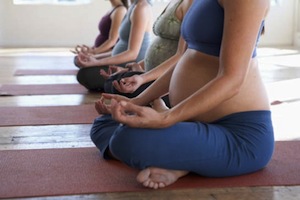Third Trimester Exercises: Advice for Expecting Mothers
Benefits of Exercising in the Third Trimester Of Pregnancy
Exercising during the third trimester of pregnancy offers numerous benefits for expectant mothers’ physical and mental well-being.
The right physical activities can help alleviate common discomforts such as constipation, back pain and swelling. It also boosts energy levels, promotes better sleep, and goes a long way to reduce the risk of excessive weight gain.
Exercise is vital in preparing the body for labour and aiding postnatal recovery.
By strengthening the pelvis, particularly the pelvic floor and abdominal muscles, women are better equipped for the physical demands of childbirth.
Staying active leads to a quicker postnatal recovery, as it helps regain lost strength and endurance and reduces the risk of gestational diabetes, pre-eclampsia, and excessive weight gain.

It is important in the third trimester to not overexercise. The best pregnancy exercises are those related to breathing, relaxation and strength.
Common Problems Experienced in the Third Trimester
During the third trimester of pregnancy, expecting mothers often experience a range of discomforts, aches and pains, including pelvic girdle pain, upper back and rib pain, and pelvic floor weakness.
Pelvic girdle pain, also known as symphysis pubis dysfunction (SPD), radiates in the pelvic region, the lower back, buttocks, and thighs. The growing uterus and hormonal changes contribute to the relaxation and loosening of ligaments, resulting in instability in the pelvic joints, making walking, climbing stairs, or performing daily activities challenging.
Upper back and rib pain are common because of the increased size and weight of the abdomen. As the uterus expands, it puts pressure on the ribs and spine, leading to discomfort and sometimes pain. Poor posture and the shift in the centre of gravity further contribute to the problem.
Pelvic floor weakness, often occurring as bladder leaking or urine incontinence, is another common problem experienced in the third trimester. The growing baby adds pressure to the bladder, leading to a frequent need to urinate. Additionally, the muscles, which support the bladder and control urine flow, can become weakened due to the weight of the uterus, resulting in accidental leakage when coughing, sneezing, or when pressure is placed on the abdomen.
How Physiotherapy Helps
Womens health physiotherapy is crucial in managing common concerns during the third trimester of pregnancy, which can significantly impact a woman’s mobility. An experienced pregnancy physiotherapist allows for balance, belly size, and physical changes when recommending exercise routines.
Techniques like manual therapy, tailored exercises, and the use of support belts are used to ease pain and improve function with pelvic girdle pain.
Postural correction, gentle stretching exercises, and breathing techniques provide relief and enhance posture when upper back and rib pain occurs.
The right exercises and good bladder habits help reduce the risks of complications throughout pregnancy. Physiotherapists target strengthening the pelvic muscles, reducing urinary incontinence and preparing the pelvic area for pushing during labour.
Using the correct physio-recommended pregnancy exercises, women will have a more comfortable experience and successful delivery.
Safe and Effective Exercises for the Third Trimester
Walking: Walking is considered a low-impact exercise that helps maintain cardiovascular fitness and promotes circulation as it helps improve balance, reduces swelling in the legs and assists in relieving back pain.
Swimming or Water Aerobics: Exercising in the water provides buoyancy, supports the growing belly, reduces joint strain, and improves muscular strength and endurance whilst minimising the risk of injury.
Prenatal Yoga or Pilates: Prenatal yoga or Pilates helps maintain flexibility, improves posture, and strengthens your core and pelvic floor. These exercises focus on breathing techniques and relaxation, which are beneficial for labour and delivery. Specialised prenatal classes ensure activities are tailored to the needs of a pregnant woman.
Body exercises and toning work: Gentle bodyweight exercises, such as squats, pelvic tilts, and modified push-ups, can help strengthen and tone muscles, especially the legs, back, and arms. These exercises should be modified in accordance with belly size and physical comfort.
Pelvic floor exercises: Also called Kegel exercises, target the muscles supporting the uterus, bladder, and bowels. Strengthening these muscles helps reduce urinary incontinence and facilitate faster recovery postpartum. Pelvic floor exercises (Kegels) can be done discreetly throughout the day.
Pregnancy Exercises to Avoid
During the third trimester of pregnancy, it is important to avoid certain exercises to ensure the safety of both the mother and the baby. These include jumping, hopping, skipping, and bouncing, as they put excessive pressure on the joints and can cause injury.
High-impact exercises like running, aerobics and contact sports should also be avoided, as they can cause overheating and stress on the body, as well as discomfort and pain in the pelvic area and increased risk of injury to the abdomen.
Exercise that involves lying flat on the back should also be avoided after the first trimester, as it can put pressure on the vena cava, reducing blood flow to the uterus.
Before starting any exercise routine, consult the doctor to ensure a safe and healthy pregnancy.
How To Prepare For Exercise
When preparing to exercise during pregnancy, there are several essential steps and considerations to remember. Firstly, choosing loose and comfortable clothing that allows for easy movement and proper ventilation is crucial. This helps prevent any restriction or discomfort while exercising.
Controlling the temperature is vital, especially during hot weather, and any exercise should occur in well-ventilated areas and at room temperature as needed.
Staying hydrated is just as important as it helps regulate body temperature and prevents dehydration, so drinking plenty of water before, during, and after exercising is essential. Additionally, wearing stable and comfortable footwear supports and prevents any potential foot or joint injuries.
Pregnant women should also listen to their bodies and take breaks when tired, avoiding overexertion and standing too long to prevent swelling and discomfort.
Exercise Smartly
During the third trimester, it is important to exercise smartly to avoid any potential risks. Loose clothing that allows free movement and comfortable footwear with good support should be worn to prevent discomfort or injury. Additionally, avoiding standing for long periods is important, as this can lead to fatigue and swelling.
Staying hydrated is also crucial. Drinking plenty of water before, during, and after exercising to stay hydrated and avoid overheating. Drinking at least 8-10 glasses of water per day is recommended.
When exercising during the third trimester, listening to your body and avoiding overexerting yourself is important. Comfortable exercises such as walking, swimming, and yoga can help maintain fitness levels without putting too much strain on the body.
Avoiding any exercises that require you to lay flat on your back for extended periods is also important. This can cause dizziness and restrict blood flow to the uterus. Instead, exercises that involve sitting or standing are recommended.
Overall, the best exercises for your third trimester can benefit both the mother and the baby. By exercising smartly and listening to your body, you can maintain your fitness levels and prepare for labour and delivery while minimising potential risks.
Conclusion
In conclusion, exercises for third-trimester pregnancies offer numerous benefits for both the mother and baby. Regular physical activity helps strengthen the muscles, control weight gain, and improve posture and overall flexibility, which can reduce discomfort and back pain commonly experienced during this trimester.
Additionally, exercise enhances cardiovascular health, promotes healthy blood circulation, and aids in maintaining healthy blood pressure levels, reducing any risk of gestational diabetes and pre-eclampsia.
It also boosts mood and reduces stress, promoting better sleep and mental well-being. Furthermore, engaging in exercises like swimming or yoga exercise can help alleviate swelling and edema, common concerns in the later stages of pregnancy.
However, it is crucial to consult with your doctor well before starting or continuing on with any exercise routine to ensure safety for both the mother and baby.
By incorporating regular exercise into their routine, pregnant women can reap these benefits and enhance their well-being during the third trimester.
If you have any questions, please contact Graceville Physio today.


